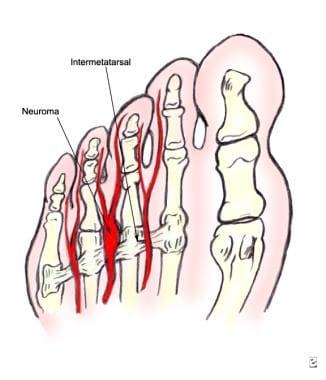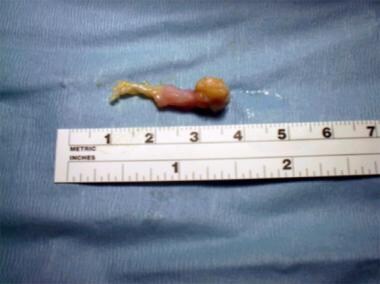Morton TG. Peculiar painful affection of fourth metatarsophalangeal articulation. Am J Med Sci. 1876. 71:37.
Munir U, Tafti D, Morgan S. Morton Neuroma. StatPearls. 2023 May 22. [QxMD MEDLINE Link]. [Full Text].
Valero J, Gallart J, Gonzalez D, Deus J, Lahoz M. Multiple interdigital neuromas: a retrospective study of 279 feet with 462 neuromas. J Foot Ankle Surg. 2015 May-Jun. 54 (3):320-2. [QxMD MEDLINE Link].
Zanetti M, Weishaupt D. MR imaging of the forefoot: Morton neuroma and differential diagnoses. Semin Musculoskelet Radiol. 2005 Sep. 9(3):175-86.
Claassen L, Bock K, Ettinger M, Waizy H, Stukenborg-Colsman C, Plaass C. Role of MRI in detection of Morton's neuroma. Foot Ankle Int. 2014 Oct. 35 (10):1002-5. [QxMD MEDLINE Link].
Pastides P, El-Sallakh S, Charalambides C. Morton's neuroma: A clinical versus radiological diagnosis. Foot Ankle Surg. 2012 Mar. 18(1):22-4. [QxMD MEDLINE Link].
Xu Z, Duan X, Yu X, Wang H, Dong X, Xiang Z. The accuracy of ultrasonography and magnetic resonance imaging for the diagnosis of Morton's neuroma: a systematic review. Clin Radiol. 2015 Apr. 70 (4):351-8. [QxMD MEDLINE Link].
Ata AM, Onat SS, Ozcakar L. Ultrasound-Guided Diagnosis and Treatment of Morton's Neuroma. Pain Physician. 2016 Feb. 19 (2):E355-8. [QxMD MEDLINE Link]. [Full Text].
Bignotti B, Signori A, Sormani MP, Molfetta L, Martinoli C, Tagliafico A. Ultrasound versus magnetic resonance imaging for Morton neuroma: systematic review and meta-analysis. Eur Radiol. 2015 Aug. 25 (8):2254-62. [QxMD MEDLINE Link].
Morgan P, Monaghan W, Richards S. A systematic review of ultrasound-guided and non-ultrasound-guided therapeutic injections to treat Morton's neuroma. J Am Podiatr Med Assoc. 2014 Jul. 104 (4):337-48. [QxMD MEDLINE Link].
Mahadevan D, Attwal M, Bhatt R, Bhatia M. Corticosteroid injection for Morton's neuroma with or without ultrasound guidance: a randomised controlled trial. Bone Joint J. 2016 Apr. 98-B (4):498-503. [QxMD MEDLINE Link].
Kim JY, Choi JH, Park J, et al. An anatomical study of Morton's interdigital neuroma: the relationship between the occurring site and the deep transverse metatarsal ligament (DTML). Foot Ankle Int. 2007 Sep. 28(9):1007-10. [QxMD MEDLINE Link].
Mahadevan D, Venkatesan M, Bhatt R, Bhatia M. Diagnostic Accuracy of Clinical Tests for Morton's Neuroma Compared With Ultrasonography. J Foot Ankle Surg. 2015 Jul-Aug. 54 (4):549-53. [QxMD MEDLINE Link].
O'Connor FG, Wilder RP, Nirschl R. Foot Injuries in the Runner. In:Textbook of Running Medicine. New York: McGraw-Hill; 2001. 258-260.
Akermark C, Saartok T, Zuber Z. A prospective 2-year follow-up study of plantar incisions in the treatment of primary intermetatarsal neuromas (Morton's neuroma). Foot Ankle Surg. 2008. 14(2):67-73. [QxMD MEDLINE Link].
Monacelli G, Cascioli I, Prezzemolo G, Spagnoli A, Irace S. [Surgical treatment of Morton's neuroma: our experience and literature review]. Clin Ter. 2008 May-Jun. 159(3):165-7. [QxMD MEDLINE Link].
Valente M, Crucil M, Alecci V. Operative treatment of interdigital Morton's neuroma. Chir Organi Mov. 2008 May. 92(1):39-43. [QxMD MEDLINE Link].
Lee KT, Lee YK, Young KW, et al. Results of operative treatment of double Morton's neuroma in the same foot. J Orthop Sci. 2009 Sep. 14(5):574-8. [QxMD MEDLINE Link].
Bucknall V, Rutherford D, MacDonald D, Shalaby H, McKinley J, Breusch SJ. Outcomes following excision of Morton's interdigital neuroma: a prospective study. Bone Joint J. 2016 Oct. 98-B (10):1376-81. [QxMD MEDLINE Link].
Valisena S, Petri GJ, Ferrero A. Treatment of Morton's neuroma: a systematic review. Foot Ankle Surg. 2017 Apr 5. [QxMD MEDLINE Link].
Villas C, Florez B, Alfonso M. Neurectomy versus neurolysis for Morton's neuroma. Foot Ankle Int. 2008 Jun. 29(6):578-80. [QxMD MEDLINE Link].
Title CI, Schon LC. Morton neuroma: primary and secondary neurectomy. J Am Acad Orthop Surg. 2008 Sep. 16(9):550-7. [QxMD MEDLINE Link].
Pace A, Scammell B, Dhar S. The outcome of Morton's neurectomy in the treatment of metatarsalgia. Int Orthop. 2010 Apr. 34(4):511-5. [QxMD MEDLINE Link].
Faraj AA, Hosur A. The outcome after using two different approaches for excision of Morton's neuroma. Chin Med J (Engl). 2010 Aug. 123(16):2195-8. [QxMD MEDLINE Link].
Kundert HP, Plaass C, Stukenborg-Colsman C, Waizy H. Excision of Morton's Neuroma Using a Longitudinal Plantar Approach: A Midterm Follow-up Study. Foot Ankle Spec. 2015 Aug 7. [QxMD MEDLINE Link].
Habashy A, Sumarriva G, Treuting RJ. Neurectomy Outcomes in Patients With Morton Neuroma: Comparison of Plantar vs Dorsal Approaches. Ochsner J. 2016 Winter. 16 (4):471-4. [QxMD MEDLINE Link]. [Full Text].
Killen MC, Karpe P, Limaye R. Plantar approach for Morton's neuroma: an effective technique for primary excision. Foot (Edinb). 2015 Dec. 25 (4):232-4. [QxMD MEDLINE Link].
Lee W, McDonald J, Azam M, Lachance AD. The comparison of postoperative outcomes in Morton's neuroma excision between plantar versus dorsal approach: A systematic review and meta-analysis. Foot Ankle Surg. 2024 Jun 5. [QxMD MEDLINE Link].
Reichert P, Zimmer K, Witkowski J, Wnukiewicz W, Kulinski S, Gosk J. Long-Term Results of Neurectomy Through a Dorsal Approach in the Treatment of Morton's Neuroma. Adv Clin Exp Med. 2016 Mar-Apr. 25 (2):295-302. [QxMD MEDLINE Link].
Lee J, Kim J, Lee M, Chu I, Lee S, Gwak H. Morton's Neuroma (Interdigital Neuralgia) Treated with Metatarsal Sliding Osteotomy. Indian J Orthop. 2017 Nov-Dec. 51 (6):692-6. [QxMD MEDLINE Link]. [Full Text].
Rout R, Tedd H, Lloyd R, et al. Morton's neuroma: diagnostic accuracy, effect on treatment time and costs of direct referral to ultrasound by primary care physicians. Qual Prim Care. 2009. 17(4):277-82. [QxMD MEDLINE Link].
Yap LP, McNally E. Patient's assessment of discomfort during ultrasound-guided injection of Morton's neuroma: selecting the optimal approach. J Clin Ultrasound. 2012 May 15. [QxMD MEDLINE Link].
Markovic M, Crichton K, Read JW, et al. Effectiveness of ultrasound-guided corticosteroid injection in the treatment of Morton's neuroma. Foot Ankle Int. 2008 May. 29(5):483-7. [QxMD MEDLINE Link].
Edwards SR, Fleming S, Landorf KB. Efficacy of a Single Corticosteroid Injection for Morton's Neuroma in Adults: A Systematic Review. J Am Podiatr Med Assoc. 2021 Jul 1. 111 (4):[QxMD MEDLINE Link].
Hau MYT, Thomson L, Aujla R, Madhadevan D, Bhatia M. Medium-Term Results of Corticosteroid Injections for Morton's Neuroma. Foot Ankle Int. 2021 Apr. 42 (4):464-8. [QxMD MEDLINE Link].
Lizano-Diez X, Gines-Cespedosa A, Alentorn-Geli E, et al. Corticosteroid Injection for the Treatment of Morton's Neuroma: A Prospective, Double-Blinded, Randomized, Placebo-Controlled Trial. Foot Ankle Int. 2017 Sep. 38 (9):944-51. [QxMD MEDLINE Link].
Park YH, Kim TJ, Choi GW, Kim HJ. Prediction of Clinical Prognosis according to Intermetatarsal Distance and Neuroma Size on Ultrasonography in Morton Neuroma: A Prospective Observational Study. J Ultrasound Med. 2019 Apr. 38 (4):1009-14. [QxMD MEDLINE Link]. [Full Text].
Fridman R, Cain JD, Weil L Jr. Extracorporeal shockwave therapy for interdigital neuroma: a randomized, placebo-controlled, double-blind trial. J Am Podiatr Med Assoc. 2009 May-Jun. 99(3):191-3. [QxMD MEDLINE Link].
Moore JL, Rosen R, Cohen J, Rosen B. Radiofrequency thermoneurolysis for the treatment of Morton's neuroma. J Foot Ankle Surg. 2012 Jan-Feb. 51(1):20-2. [QxMD MEDLINE Link].
Moulin B, Angelopoulos G, Sarrazin JL, et al. Safety and Efficacy of Percutaneous Morton Neuroma Cryoneurolysis Under Ultrasound Guidance. Cardiovasc Intervent Radiol. 2024 Jun. 47 (6):795-800. [QxMD MEDLINE Link].
Mahadevan D, Salmasi M, Whybra N, Nanda A, Gaba S, Mangwani J. What factors predict the need for further intervention following corticosteroid injection of Morton's neuroma?. Foot Ankle Surg. 2016 Mar. 22 (1):9-11. [QxMD MEDLINE Link].
 Plantar view showing the relationships between the metatarsal heads, the intermetatarsal ligament, and the neuroma.
Plantar view showing the relationships between the metatarsal heads, the intermetatarsal ligament, and the neuroma.


